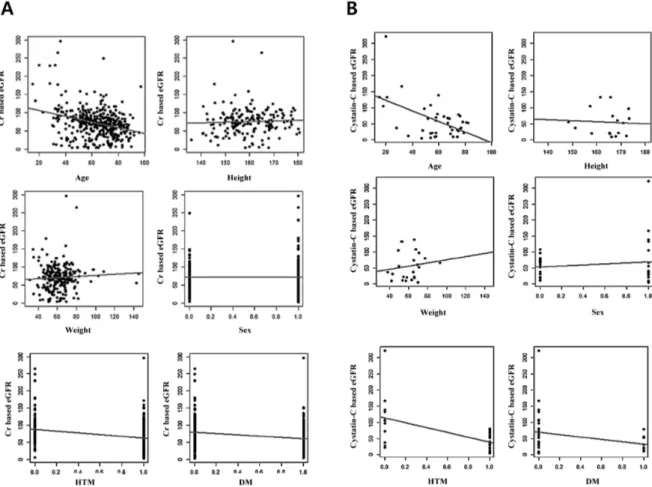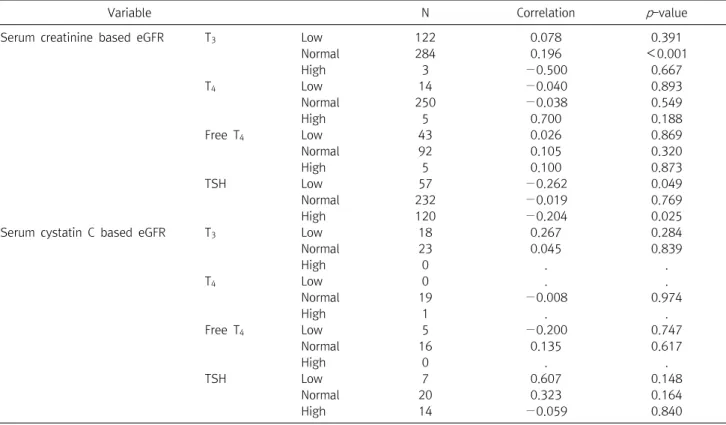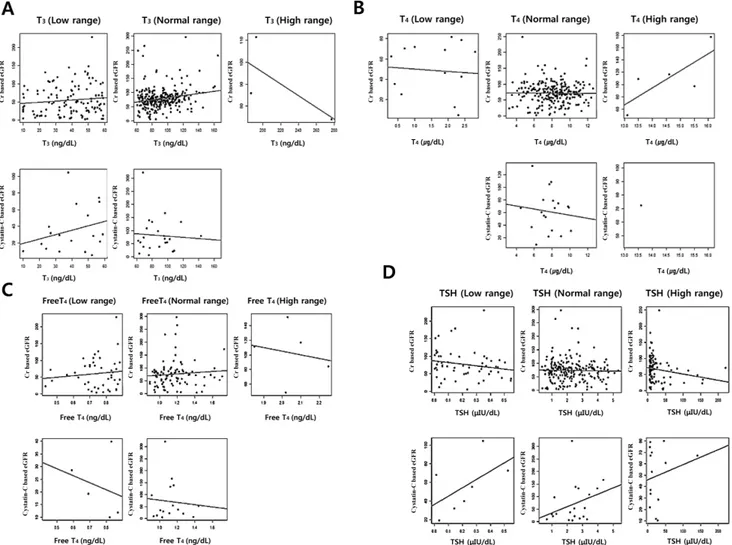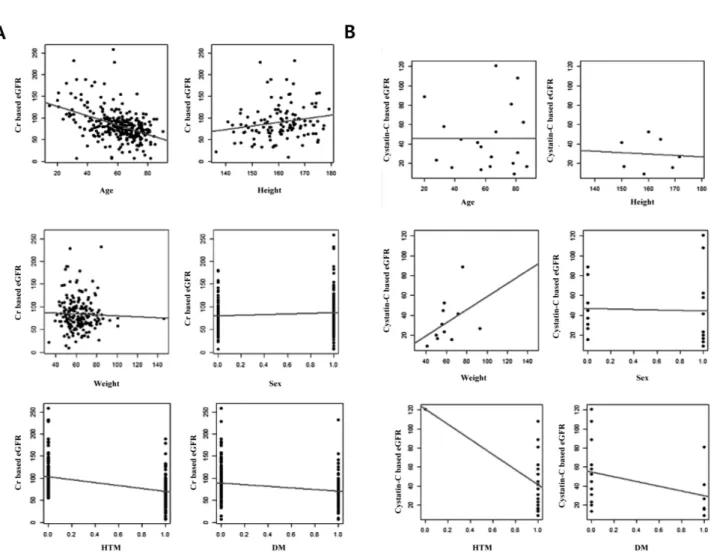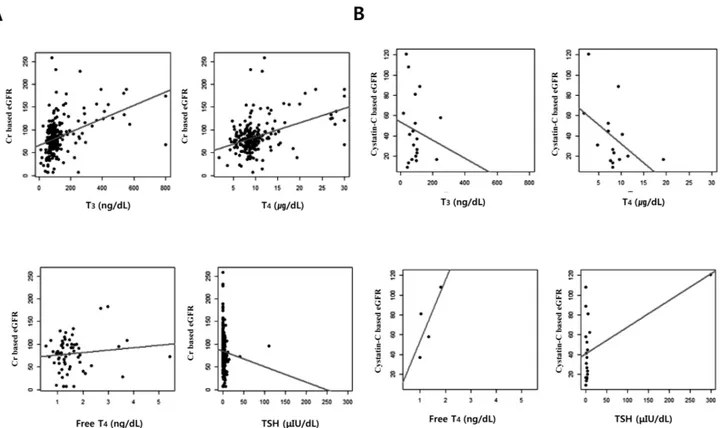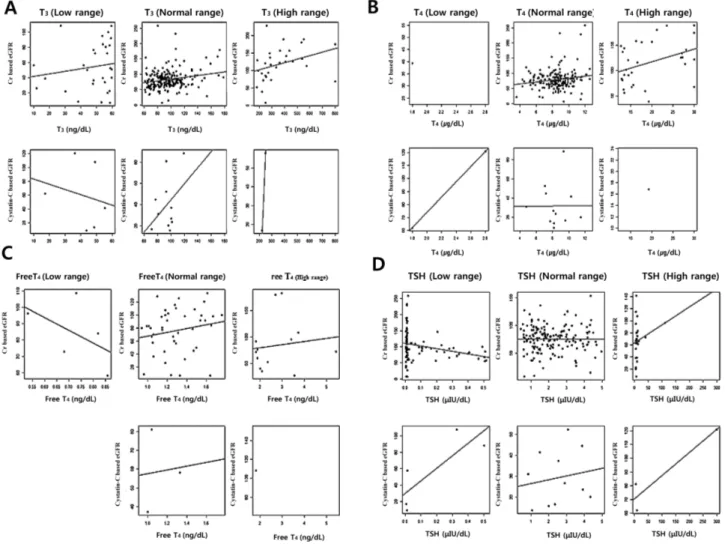pISSN 1738-3544 eISSN 2288-1662
A Correlation Analysis of Serum Creatinine Based eGFR and Serum Cystatin C Based eGFR with Thyroid
Dysfunction Patients
Gu Lim 1,2,3 , Hyung-Doo Park 3 , Ho Joong Sung 1,2
1
Department of Biomedical Laboratory Sciences, College of Health Science, Eulji University, Seongnam, Korea
2
BK21 Plus Program, Department of Senior Healthcare, Graduate School, Eulji University, Daejeon, Korea
3
Department of Laboratory Medicine, Samsung Medical Center, Sungkyunkwan University School of Medicine, Seoul, Korea
갑상선기능이상 환자에서 크레아티닌과 시스타틴을 이용한 사구체여과율 검사결과의 상관성 연구
임 구 1,2,3 , 박형두 3 , 성호중 1,2
1
을지대학교 보건과학대학 임상병리학과,
2을지대학교 대학원 시니어헬스케어학과,
3성균관대학교 의과대학 삼성서울병원 진단검사의학교실
Serum creatinine-based eGFR and serum cystatin C-based eGFR are the most popular methods for measuring renal function. Thyroid hormone is known to affect serum creatinine-based eGFR and serum cystatin C-based eGFR; however, the clinical significance of thyroid dysfunctional patients of renal function evaluation has not been fully elucidated to date. This study examined the effect of thyroid hormone on serum creatinine-based eGFR and serum cystatin C-based eGFR. Moreover, we also evaluated the correlation analysis between serum creatinine-based eGFR and serum cystatin C-based eGFR in patients with thyroid dysfunction. A total of 442 patients with hypothyroidism and 284 patients with hyperthyroidism were investigated. A correlation analysis between thyroid hormone and serum creatinine- (and cystatin C-) based eGFR was performed. A correlation analysis between thyroid hormone and serum cystatin-C based eGFR indicated that serum cystatin-C based eGFR is more of an independent biomarker than serum creatinine-based eGFR in thyroid dysfunction patients. Therefore, serum cystatin C-based eGFR more accurately reflects renal function than serum creatinine-based eGFR in thyroid dysfunction patients.
Key words: Creatinine, Cystatin C, eGFR, Thyroid dysfunction
Corresponding author: Hyung-Doo Park Department of Laboratory Medicine, Samsung Medical Center, Sungkyunkwan University School of Medicine, 81 Irwon-ro, Gangnam-gu, Seoul 06351, Korea
Tel: 82-2-3410-0290 Fax: 82-2-3410-2719
E-mail: hyungdoo.park@samsung.com Co-Corresponding author: Ho Joong Sung Department of Biomedical Laboratory Sciences, College of Health Science, Eulji University, 553 Sanseong-daero, Soojeong-gu, Seongnam 13135, Korea Tel: 82-31-740-7306
Fax: 82-31-740-7425 E-mail: hjsung@eulji.ac.kr
This is an Open Access article distributed under the terms of the Creative Commons Attribution Non-Commercial License (http://creativecommons.org/licenses/by-nc/4.0) which permits unrestricted non-commercial use, distribution, and reproduction in any medium, provided the original work is properly cited.
Copyright © 2017 The Korean Society for Clinical Laboratory Science. All rights reserved.
Received: July 25, 2017 Revised 1st: July 31, 2017 Revised 2nd: August 2, 2017 Accepted: August 2, 2017

